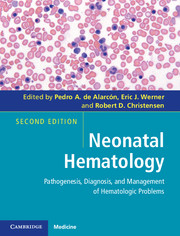Book contents
- Frontmatter
- Contents
- Contributors
- Foreword
- Preface
- 1 A historical review
- Section I Developmental hematology
- Section II Erythrocyte disorders
- Section III Platelet disorders
- Section IV Leukocyte disorders
- Section V Immunologic disorders
- Section VI Hemostatic disorders
- Section VII Transfusional medicine
- 18 Transfusion practices
- 19 Umbilical cord blood transplantation
- Section VIII Miscellaneous
- Index
- Plate section
- References
18 - Transfusion practices
from Section VII - Transfusional medicine
Published online by Cambridge University Press: 05 February 2013
- Frontmatter
- Contents
- Contributors
- Foreword
- Preface
- 1 A historical review
- Section I Developmental hematology
- Section II Erythrocyte disorders
- Section III Platelet disorders
- Section IV Leukocyte disorders
- Section V Immunologic disorders
- Section VI Hemostatic disorders
- Section VII Transfusional medicine
- 18 Transfusion practices
- 19 Umbilical cord blood transplantation
- Section VIII Miscellaneous
- Index
- Plate section
- References
Summary
Neonatal transfusion therapy requires an understanding of the dynamic interactions of the fetomaternal unit, the physiologic changes that accompany the transition from fetus to neonate to infant, and the underlying pathophysiology of different hematologic disorders. Guidelines for neonatal transfusions remain controversial, since most have been extrapolated from evidence in adults or based on small studies in neonates with marginal statistical validity. Compared with older children and adult’s, neonates have small total blood volumes but a high blood volume per body weight. Because of the limited capacity to expand their blood volume to compensate for their rapid growth, many sick and/or premature infants require significant blood component support, especially within the first weeks of life. Immaturity of many organ systems predisposes them to metabolic derangements from blood products and their additive solutions, and to the infectious and immunomodulatory hazards of transfusion such as transfusion-acquired cytomegalovirus (TA-CMV) infection and transfusion-associated graft vs. host disease (TA-GVHD). Therefore, component modifications are often required to compensate for the infant’s small blood volume, immunologic immaturity, and/or compromised organ function, and constitute the uniqueness of neonatal transfusion therapy.
Pretransfusion testing
A sample of cord blood is often collected in newborn infants at the time of delivery, but routine testing of cord blood for ABO group and Rh type is not necessary for healthy newborn infants unless the mother is Rh-negative and/or has a positive antibody screen (4). ABO and Rh type should be determined on samples obtained from both mother and baby for sick infants. Cord blood may be used for initial testing, but should be confirmed with an infant’s sample. The infant’s blood group is determined from the red cells alone, since the corresponding isoagglutinins anti-A and anti-B in the serum/plasma are usually weak or absent. Screening for atypical antibodies may be performed on maternal blood if available, or in the neonatal serum/plasma. A conventional cross-match is unnecessary if atypical antibodies are not demonstrable.
- Type
- Chapter
- Information
- Neonatal HematologyPathogenesis, Diagnosis, and Management of Hematologic Problems, pp. 303 - 327Publisher: Cambridge University PressPrint publication year: 2013



